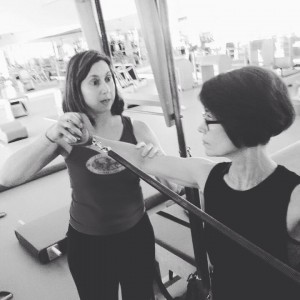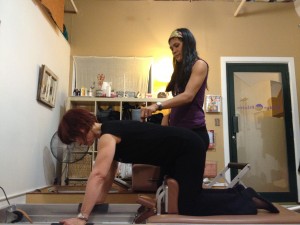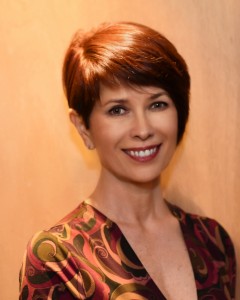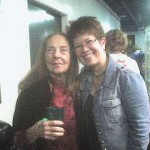On Becoming Great – A Work in Progress
by Colleen Wenrich
I’ve been doing this a long time. Recently, I calculated that I’ve provided more than 17,000 hours of teaching. The book says that makes me an “Outlier”. Still, I know I’m not yet “perfect” in the kind of teacher I want to be. I’ve taken lessons from a variety of top teachers and trained in both large, bustling studios and in small, boutique studios. Workshops and conferences, hours of archival footage, taking duets and trios with my peers. Every experience certainly gives me insight into the work. But I ask myself, “What makes a great teacher? What do I have? What do I still lack?”
I think about what I’ve considered to be the best lessons, as a Pilates student, that I’ve ever taken. What made them stand out in my mind? Why did I want to repeat that experience, and often?
I’ve taken from brilliant “performers” of Pilates. People who were physically gifted and beautifully proportioned. They were fine lessons, but they didn’t stand out, particularly, as the “best lessons”. I’m not a dancer or a gymnast, and I’ll never look like one. While it might be nice, it’s not my goal. That’s what I learned from them.
I remember lessons from vastly experienced teachers that, while I felt lucky to work with them, didn’t feel good when I left for the day. I wanted to know, “Why not?” Why didn’t I want to continue with them? Maybe it was because sometimes while the feedback was accurate, it wasn’t feedback on what I was working on personally. It became a picky distraction. And I think sometimes the delivery could come off as too judgmental. I don’t like feeling judged. I don’t like the aftertaste.
I need to remember this. My best lessons made me feel good, not just physically, but mentally. Inspired. Romana always made me feel this way. It was a total revelation to laugh belly-laughs in my lessons with Jerome at Drago’s. The work is important and beautiful, but why so serious? I learned a great lesson is joyful, and often funny. I tell my students when they laugh during an exercise that they’re doing “advanced powerhouse work”.
When I think of how I felt during a great lesson, I remember feeling fully engaged, involved, and consulted, almost like a collaborator. I wasn’t just told what to do; I was an active participant in the process. Makes sense – it’s my body.
I am reminded of one cueing method that Lori Coleman-Brown would often use: “Let me make a suggestion; how would it feel if we tried this …?” Such a simple thing to say, but it opened the experience. It didn’t say ‘Learn this!’. It said “What do we learn if we try this?” There was no wrong answer. No judgment – just an opportunity to learn. And very empowering. I learned that I want my students to feel involved and empowered.

I have similarly great experiences with Blossom Leilani. There is a bright enjoyment of the work in her lessons that is contagious. She leads and suggests, and is confident enough to let the result determine where the lesson goes. Always an adventure, and so much fun! What wild cat would we encounter this week?

I remember, back in the infancy of my teaching career with my certificate in hand, I was armed with many hours of repetition of exercises and their “orders”. I was certified to teach, but not yet a teacher of Pilates. I relied heavily on those orders, but saw times where they restrained the learning rather than promoted it. There was more to Pilates than cool exercises and orders. There were individual people walking into the studio each day, each with their own stories and intelligence. What was easy for one was hard for the next. What was the difference? Wasn’t it more than “this body has a weakness here – that body doesn’t”?
Insanity has been defined as repeating an action over and over and expecting a different result. When I made the leap of this recognition, my Pilates instruction came to life – the people were not cookie cutter and their lessons couldn’t be either!
Gradually, I began to have the courage to move a student to another apparatus where an analogous exercise would better teach the feeling of that particular exercise in the “order”, then take them back to the original apparatus and resume.
This has worked well over the years to address individual issues, but I’ve learned that the Pilates work needs the order not only for balancing the body, but for the empowerment of the student. And here we go back again to the fundamentals. My goal is for my student to be aware of what their body needs inside the Pilates work and to be able to take charge of their work. The student knowing the order provides a framework for that autonomy.
So, here I am – always moving to become a better teacher. I’m working on a balancing act of going deeper into an exercise out of the order to address whatever it is they’re working on, taking what we’ve discovered back to the order, consulting the wisdom of the student while reinforcing autonomy by giving them the responsibility to learn the order, while keeping the student fully involved as a problem solver, being adaptable and, in the end, leaving them laughing.
All in a day’s work. It’s good work. And someday, I hope to be great.
I’m working on it.
Colleen  Wenrich owns and operates Whole Pilates, a small boutique studio in Ringwood, New Jersey. A registered nurse since 1978, Colleen did her apprenticeship as an independent student directly under Romana Kryzanowska in Authentic Classical Pilates. She makes a point of taking workshops and lessons with as many first generation teachers as are still available, such as Sari Mejia Santos, Jay Grimes, Kathy Grant, Lolita San Miguel, as well as prominent 2nd generation teachers, such as Anthony Rabara, Lori Coleman-Brown, Blossom Lelaini, and many others. She believes that a huge part of being a teacher is to never stop being also a student. Colleen has been teaching fitness and wellness individually and corporately since 1981.
Wenrich owns and operates Whole Pilates, a small boutique studio in Ringwood, New Jersey. A registered nurse since 1978, Colleen did her apprenticeship as an independent student directly under Romana Kryzanowska in Authentic Classical Pilates. She makes a point of taking workshops and lessons with as many first generation teachers as are still available, such as Sari Mejia Santos, Jay Grimes, Kathy Grant, Lolita San Miguel, as well as prominent 2nd generation teachers, such as Anthony Rabara, Lori Coleman-Brown, Blossom Lelaini, and many others. She believes that a huge part of being a teacher is to never stop being also a student. Colleen has been teaching fitness and wellness individually and corporately since 1981.

